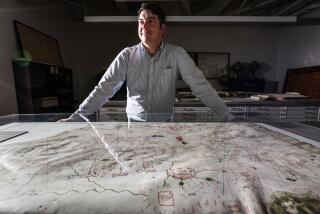Map Is Prized Piece in the Aztec Show
- Share via
DENVER — A delicate picture map painted on deerskin is one of the rare treasures exploring the mysteries of the ancient Aztecs in a Denver Museum of Natural History exhibition.
The faded map on show in “Aztec: The World of Moctezuma” is known as a lienzo. It was probably produced by an Aztec scribe in the years after the conquest of the 20-million-strong empire in the Valley of Mexico by Spanish explorers in 1521.
The lienzo is on loan from the Western American collection of Princeton University Library, which was recently given the map by a private collector. The Denver exhibit is the first time the lienzo has been shown publicly.
The Aztecs had no written alphabet. Instead, they relied on symbolic pictures, or pictographs, to communicate. Scholars believe the pictographs were reserved for important affairs.
Everything from genealogies, harvests, calendars, rituals and battles were recorded in pictographs, usually on fig-tree paper.
Measuring about 3 feet long, it’s a local document that depicts important village information and offers anthropologists a rare glimpse into everyday Aztec life. But the map contains no clues to the location of the town depicted on it.
“We’re not even sure what community it comes from,” one expert said. “Several scholars have looked at it. They are still trying to nail down which part of the valley (of Mexico) it is.”






